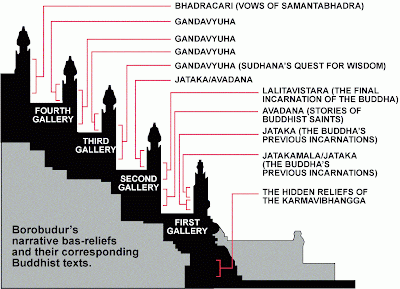 Molecular analysis shows giant rafflesia flower grew 79-fold over millions of years.
The plant with the world's largest flower - typically a full meter across, with a bud the size of a basketball - evolved from a family of plants whose blossoms are nearly all tiny, botanists write this week in the journal Science. Their genetic analysis of rafflesia reveals that it is closely related to a family that includes poinsettias, castor oil plants, the tropical root crop cassava, and the trees that produce natural rubber.
The team from Harvard University, Southern Illinois University, the Smithsonian Institution, and the University of Wisconsin was led by Harvard's Charles C. Davis. "For nearly 200 years rafflesia's lineage has confounded plant scientists," says Davis, an assistant professor of organismic and evolutionary biology in Harvard's Faculty of Arts and Sciences. "As a parasite living inside the tissue of a tropical vine, the plant lacks leaves, shoots, or roots, making it difficult to compare to more conventional plants. Most efforts to place plants in the botanical tree of life in the past 25 years have tracked ancestry using molecular markers in genes governing photosynthesis. Rafflesia is a non-photosynthetic parasite, and those genes have apparently been abandoned, meaning that to determine its lineage we had to look at other parts of the plant's genome."
Davis and his colleagues determined that over an estimated 46 million years, rafflesia's blooms, which now weigh up to 15 lbs., evolved at an accelerated pace. However, after increasing in size by a factor of roughly 79, the plant then reverted to a more sedate evolutionary pace.
This evolutionary spurt is one of the most dramatic size changes ever reported among eukaryotes; if humans were to undergo comparable evolutionary growth, Davis says, an average man would end up some 146 meters tall, roughly the height of the Great Pyramid of Giza.
Because rafflesia lacks the genes most commonly used to trace plant ancestry, the scientists delved deeper into the genome, looking at some 11,500 base pairs of DNA to determine that the giant flower's closest relatives are in the Euphorbiaceae family, many of which have blossoms just a few millimeters in diameter.
"The power of nucleic acid comparisons is revealed as well as ever in this stunning deduction," says noted botanist Peter H. Raven, president of the Missouri Botanical Garden in St. Louis, about his fellow scientists’ discovery. "The massive increase in flower size is one of the most significant among living organisms, and could never have been deduced by conventional methods."
Found growing on the jungle floor in parts of southeastern Asia, rafflesia is unusual in more than just its flower's size. A parasite, it derives its nutrients from a plant in the grapevine family and lacks leaves, stems, or roots. More dramatic is the plant's carcass-like appearance: Its blooms are a mottled blood red, reek of decaying flesh, and in some cases even emit heat, much like a recently killed animal. These traits help the flower attract the carrion flies that pollinate it.
"While it's surprising to find this giant plant evolved from a family typified by much smaller blossoms, rafflesia is unusual enough that it's frankly been difficult to imagine it fitting neatly into any plant family," Davis says. "Many botanists had refused to even speculate on where this botanical outlier might fit into the tree of life."
Rafflesia was first discovered in the Sumatran rain forest some 180 years ago by Sir Stamford Raffles, governor of the East India Company's establishments in Sumatra, and Joseph Arnold, a naturalist and physician. Shortly before Arnold died of malaria on the same expedition the flower was discovered, he described rafflesia as "the greatest prodigy of the vegetable world," adding, "To tell you the truth, had I been alone, and had there been no witnesses, I should think I would have been fearful of mentioning the dimensions of this flower, so much does it exceed every flower I have ever seen or heard of."
Photo : Rafflesia Arnoldii, Batang Palupuh, Sumatra, Indonesia. (Original Sources : By Steve Bradt, FAS Communications, Copyright 2006
by the President and Fellows of Harvard College, Photo Source : id.wikipedia.org/wiki/Berkas:Rafflesia_Arnoldii_Batang_Palupuah_Indonesia.jpg
Molecular analysis shows giant rafflesia flower grew 79-fold over millions of years.
The plant with the world's largest flower - typically a full meter across, with a bud the size of a basketball - evolved from a family of plants whose blossoms are nearly all tiny, botanists write this week in the journal Science. Their genetic analysis of rafflesia reveals that it is closely related to a family that includes poinsettias, castor oil plants, the tropical root crop cassava, and the trees that produce natural rubber.
The team from Harvard University, Southern Illinois University, the Smithsonian Institution, and the University of Wisconsin was led by Harvard's Charles C. Davis. "For nearly 200 years rafflesia's lineage has confounded plant scientists," says Davis, an assistant professor of organismic and evolutionary biology in Harvard's Faculty of Arts and Sciences. "As a parasite living inside the tissue of a tropical vine, the plant lacks leaves, shoots, or roots, making it difficult to compare to more conventional plants. Most efforts to place plants in the botanical tree of life in the past 25 years have tracked ancestry using molecular markers in genes governing photosynthesis. Rafflesia is a non-photosynthetic parasite, and those genes have apparently been abandoned, meaning that to determine its lineage we had to look at other parts of the plant's genome."
Davis and his colleagues determined that over an estimated 46 million years, rafflesia's blooms, which now weigh up to 15 lbs., evolved at an accelerated pace. However, after increasing in size by a factor of roughly 79, the plant then reverted to a more sedate evolutionary pace.
This evolutionary spurt is one of the most dramatic size changes ever reported among eukaryotes; if humans were to undergo comparable evolutionary growth, Davis says, an average man would end up some 146 meters tall, roughly the height of the Great Pyramid of Giza.
Because rafflesia lacks the genes most commonly used to trace plant ancestry, the scientists delved deeper into the genome, looking at some 11,500 base pairs of DNA to determine that the giant flower's closest relatives are in the Euphorbiaceae family, many of which have blossoms just a few millimeters in diameter.
"The power of nucleic acid comparisons is revealed as well as ever in this stunning deduction," says noted botanist Peter H. Raven, president of the Missouri Botanical Garden in St. Louis, about his fellow scientists’ discovery. "The massive increase in flower size is one of the most significant among living organisms, and could never have been deduced by conventional methods."
Found growing on the jungle floor in parts of southeastern Asia, rafflesia is unusual in more than just its flower's size. A parasite, it derives its nutrients from a plant in the grapevine family and lacks leaves, stems, or roots. More dramatic is the plant's carcass-like appearance: Its blooms are a mottled blood red, reek of decaying flesh, and in some cases even emit heat, much like a recently killed animal. These traits help the flower attract the carrion flies that pollinate it.
"While it's surprising to find this giant plant evolved from a family typified by much smaller blossoms, rafflesia is unusual enough that it's frankly been difficult to imagine it fitting neatly into any plant family," Davis says. "Many botanists had refused to even speculate on where this botanical outlier might fit into the tree of life."
Rafflesia was first discovered in the Sumatran rain forest some 180 years ago by Sir Stamford Raffles, governor of the East India Company's establishments in Sumatra, and Joseph Arnold, a naturalist and physician. Shortly before Arnold died of malaria on the same expedition the flower was discovered, he described rafflesia as "the greatest prodigy of the vegetable world," adding, "To tell you the truth, had I been alone, and had there been no witnesses, I should think I would have been fearful of mentioning the dimensions of this flower, so much does it exceed every flower I have ever seen or heard of."
Photo : Rafflesia Arnoldii, Batang Palupuh, Sumatra, Indonesia. (Original Sources : By Steve Bradt, FAS Communications, Copyright 2006
by the President and Fellows of Harvard College, Photo Source : id.wikipedia.org/wiki/Berkas:Rafflesia_Arnoldii_Batang_Palupuah_Indonesia.jpg
)
 History
It appears that the Chinese were the first to miniaturize container-grown trees around 200 AD. The art form may be derived from the practice of transporting medicinal plants in containers by healers. Its early focus was on the display of stylistic trunks in the shape of animals and mystic figures.
History
It appears that the Chinese were the first to miniaturize container-grown trees around 200 AD. The art form may be derived from the practice of transporting medicinal plants in containers by healers. Its early focus was on the display of stylistic trunks in the shape of animals and mystic figures. Techniques
Shaping and dwarfing are accomplished through a few basic but precise techniques. The small size of the tree and the dwarfing of foliage are maintained through a consistent regimen of pruning of both the leaves and the roots. Various methods must be employed, as each species of tree exhibits different budding behavior. Additionally, some pruning must be done seasonally, as most trees require a dormancy period and do not grow roots or leaves at that time; improper pruning can weaken or kill the tree.
Techniques
Shaping and dwarfing are accomplished through a few basic but precise techniques. The small size of the tree and the dwarfing of foliage are maintained through a consistent regimen of pruning of both the leaves and the roots. Various methods must be employed, as each species of tree exhibits different budding behavior. Additionally, some pruning must be done seasonally, as most trees require a dormancy period and do not grow roots or leaves at that time; improper pruning can weaken or kill the tree.

















